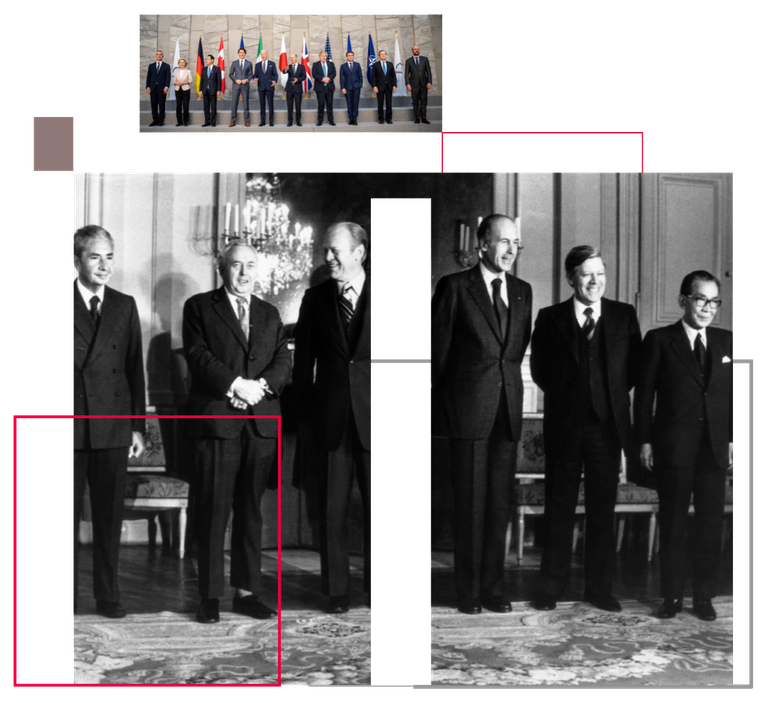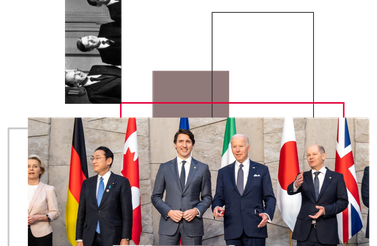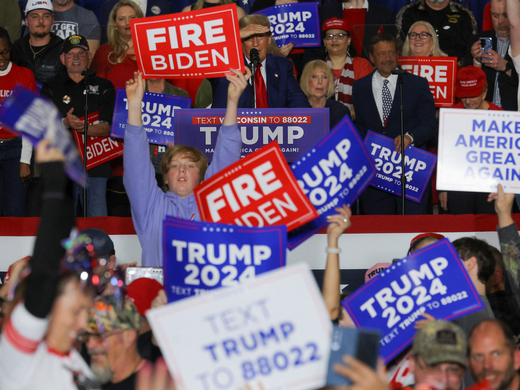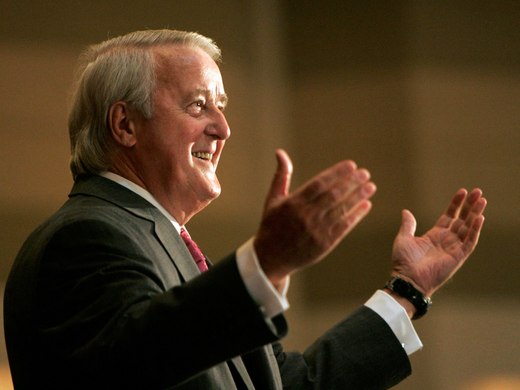The first economic summit of the Cold War met outside Paris, France, in November 1975. At the summer residence of the French president, an exclusive club of countries — France, Germany, Italy, Japan, the United Kingdom and the United States — met to exchange views on predefined topics related to the ongoing currency and energy crises. Initial reports were hardly positive. According to The New York Times, “its impact was so amorphous that it already appears to be slipping quietly into the dim recesses that history reserves for minor footnotes about insubstantial events” (Shabecoff 1975). A White House official compared it to a “religious retreat” (ibid.), a kind of declaration of faith in the ability of industrial democracies to weather the economic storms of unemployment and inflation, but nothing more. Without meaningful policy decisions, concluded The Economist, “Chateau Rambouillet 1975 is already slightly corked” (The Economist 1975, 69). In spite of the pessimism, this first meeting in France ultimately spawned the Group of Seven (G7), and its complementary Group of Twenty, two international economic institutions that have persevered to this day.
Since the Bretton Woods Conference of 1944, the global monetary system had functioned according to fixed exchange rates and an International Monetary Fund (IMF) to bridge temporary imbalances of payments. But as economist Robert Triffin had warned before Congress,1 the accumulation of dollars overseas — some via post-Second World War Marshall Plan aid money — brought into doubt the capacity of the US government to convert dollars into gold at the official rate of $35 per ounce. One possible solution was devaluing the dollar, but this would only punish those allies who had held onto their reserves, namely Japan, West Germany and Canada.
Canada’s balance of payments had always been vulnerable to the capriciousness of US politics. These vulnerabilities were fully exposed by US President Richard Nixon’s New Economic Policy, where Canada was no longer exempt from 10 percent import surcharges (Goodman 2008). These measures, and abandoning the gold standard (Amadeo 2021), became known as the Nixon Shokku — a nod to his false assumption that Japan was America’s largest trading partner.
Destroying Bretton Woods and establishing an alternative international monetary order was not the goal of the Nixon administration, but by fixating on national prosperity with little regard to the consequences for international economic governance, it did just that. Inflation and unemployment — two phenomena that previously no one thought could rise together — soared. The stagnant economy of the 1970s assumed a new portmanteau, stagflation, and it overhauled the entire economic system.
The so-called contagion of protectionism needed to be contained, and Rambouillet served as a first step in doing so. To lament that its final communiqué made no mention of future gatherings nor policy breakthroughs, as The New York Times did, misses its point. The purpose of the meeting was psychological: to restore the West’s collective self-confidence. It set a path in creating a more robust alliance among advanced liberal democracies.
The 1970s were the ugly, rough draft of trade, investment and development policy we are seeing today. The Cold War was one major theme of postwar international history, but so was globalization. And globalization without governance left open how global dilemmas, such as climate change and financial crises, might be managed in the future. Consider the language of the 1975 joint statement, and how it could just as easily apply today:
International trade is one of the most powerful forces for long term growth and to lower inflation. To maintain an open trading system in a period where pressures are developing for a return to protectionism the main trading nations must avoid resorting to measures by which they could try to solve their problems at the expense of others and which could lead to economic, social and political evils. Moreover it is necessary to expand world trade and we believe that multilateral trade negotiations should be accelerated. They should aim at substantial tariff cuts, even eliminating tariffs in some commodity areas, and significantly improving the regime for agricultural trade, and at reducing non-tariff measures. (G7 Leaders 1975)
What is more, although it was not recognized at the time, Rambouillet marked the first sweeping revision of international monetary arrangements since Bretton Woods. (Offstage talks that started in France to modify the IMF Articles of Agreement were ratified the following year at the Jamaica meeting of the Interim Committee of the IMF.2) In exchange for Washington’s pledge to maintain orderly exchange rates, Paris committed to outlaw currency manipulation. The IMF’s official historian described the agreement as the “early embodiment” of the new economic dogma favouring free markets and private enterprise over government regulation (De Vries 1986, 761).
Canada’s deliberate exclusion from that first meeting by French President Valéry Giscard d’Estaing is critical to the longer story of Canada’s bilateral relationship with the United States and engagement on the world stage. At the time, France ranked fourth after the United States, Japan and the Netherlands in terms of foreign investment in Canada, particularly in uranium (Bothwell 1984) and hydrocarbons.3 Even still, the French viewed Canada as a satellite of American interests.
As planning got under way, US President Gerald R. Ford bluntly told Giscard, “I continue to feel strongly that Canadian participation is justified given Canada’s role in the world. As I have already pointed out to you, Canada is our largest trading partner; our economies are intimately connected. Its absence from our deliberations would not be understood in this country.”4 On the same day he expressed this frustration to Giscard, Ford also communicated his exasperation to the leaders of Britain5 and Germany6 that he “could not believe that our French colleague would persist in a position that could only detract from the promise of the enterprise.” It made sense for the meeting to be small, but if Italy could be invited to strengthen its North Atlantic Treaty Organization (NATO)-friendly government in the face of a Communist threat, surely Canada, with its larger economy, could be included as well.
As Berkeley historian Daniel J. Sargent has written (2017), economic summitry reoriented Western alliances to new purposes and policy coordination promised to bolster economic and social stability at a time when Communist parties in Europe were strengthening; today, the threat is from authoritarian regimes.
Economic summitry reoriented Western alliances to new purposes and policy coordination promised to bolster economic and social stability at a time when Communist parties in Europe were strengthening; today, the threat is from authoritarian regimes.
The Americans had been so sure of Canada’s participation that their draft press releases always included “[Canada]” in brackets, and any time the number of countries was listed, “[7]” was bracketed, too. Ford’s advocacy was ultimately unsuccessful, but he did not concede. He warned the French leader: “in all candor…while I have agreed to come to this meeting…it is difficult for me, in the circumstances that have arisen, to contemplate future gatherings of this kind.”7
Whether intentionally — by not being exempt from the Nixon surcharges — or unintentionally, Ford could not get his way; these experiences made the United States seem like an unreliable neighbour.
Canadian foreign policy shifted to realism, as Prime Minister Pierre Trudeau recognized the People’s Republic of China, increased foreign aid and established closer relations with developing nations, such as India and Cuba. The government’s foreign policy review from 1970 focused on the United Nations and international development, and the geographical areas of Europe, Latin America and the Pacific (Franks 2006a).
The government had handed over economic matters related to the United States for consideration by a separate task force under the direction of Herb Gray, at the time Canada’s minister of national revenue (Franks 2006b). Canadians eagerly anticipated the government’s plans to limit the impact of American money and culture, which were seemingly hollowing out the country. Institutions such as the Foreign Investment Review Agency and the National Energy Program were the eventual result; as historian Stephen Azzi (2007) has shown, foreign investment was decreasing at the time, so the former seemed a misplaced endeavour if the metric was economic and not emotion, and the latter alienated western Canada then, and its legacy still does today. The United States had started paying attention to Canadian nationalism, but really only began to take Canada’s threats on monitoring foreign investment seriously when Mexico thought about doing the same (de Onis 1970).
Meanwhile, Trudeau visited France in October 1974 to “fonder les neiges,” or thaw relations between the two countries. That month, US Secretary of State Henry Kissinger met Canada’s minister of external affairs, Allan MacEachen, acknowledging Canada was no longer a “minor partner” on the world stage (Kissinger, quoted in Martin 2006).
Shortly thereafter, Giscard met with Ford. This meeting was shrouded in controversy as news got out that Kissinger said he did not want the two to be left alone at any moment.8 Nonetheless, in Martinique in December 1974, they affirmed that informal cooperation among the most powerful countries would substitute for the rules-based approach to the international monetary order that had existed under Bretton Woods (Lewis 1974). Smaller European nations or developing countries could instead be part of the IMF.9 Its role would be diminished (Office of the White House Press Secretary 1974); the IMF would enforce, not make, the rules. This loose framework evolved into a tangible plan for an international economic summit.
More important for Canada, at least at the time, was the signing of the 1974 US Trade Act that gave, and continues to give, the president the power to unilaterally apply protectionist measures. Section 301 means the president can, in violation of rules set forth in the General Agreement on Tariffs and Trade (GATT), take all measures necessary to protect American products not just in the United States, but in other markets, too (Levinson 2016). It is the section that President Donald Trump invoked against China (Office of the United States Trade Representative 2019) but has also been used regarding Canadian softwood lumber (Congressional Research Service 2022).
Giscard did not want his summit to resemble the Organisation for Economic Co-operation and Development (OECD) or something traditional.10 He argued that Canada had not been as adversely impacted by the economic crises of the early 1970s because its economy relied so heavily on the export of natural resources. Canada could make decisions in existing institutions of which it was already a full member, such as the OECD, IMF and GATT, Giscard offered (CBC Radio 1975). To make up for its dismissal at Rambouillet, Canada was made the chair of a North-South energy conference on economic cooperation, which led to the Washington Energy Conference and the creation of the International Energy Agency in November 1974.11
Seven months after Rambouillet, a second summit was held in Puerto Rico (Office of the White House Press Secretary 1976). Canada was included, but not without similar squabbles. The French wanted the invitation to be clear that Canada was only being invited because of its geography (both it and the meeting were in the western hemisphere) and at the request of the American president. This language was meant to ensure France could keep a veto over Canadian participation at any future events. The novelty of summitry had already worn off by this point and results were inconclusive, but Puerto Rico sustained a dialogue among the G7 countries. A third meeting was held in London in May 1977 and focused on more concrete actions.
Ironically, despite France’s opposition to Canada’s participation in the summits, French language connections have been a substantial part of Canada’s international assistance program since 1970. Like the rest of the economic system, foreign aid has its roots in the success of the Marshall Plan that channelled aid to reconstruct Europe. Canada’s program began in this period of optimism, first through the 1950s Colombo Plan (Stairs 2006). Ottawa’s original commitment aimed to support the recently independent Commonwealth countries of Asia, but later expanded to French-speaking Africa and the broader la Francophonie. The Canadian International Development Agency (CIDA) was founded and accepted the target of dedicating 0.70 percent of GDP (now gross national income) to foreign aid in 1970. Canada has yet to hit that target but has twice exceeded 0.50 percent (under Prime Ministers Pierre Trudeau and Brian Mulroney). In 2013, CIDA was controversially merged into Canada’s foreign affairs department (Schwartz 2013).
As for ties to the United States, it has been a long time since Canada has felt the kind of support Ford showed at Rambouillet. After all, at the 2018 G7 summit in Charlevoix, Quebec, President Trump left in a huff, and retracted US support for the closing statement while criticizing Prime Minister Justin Trudeau as “very dishonest and weak” (Paletta and Achenbach 2018).
Still, some lessons learned from those early summits persist. When successive US administrations blocked the appointment of new judges to a World Trade Organization dispute resolution tribunal, the Canadian government pursued offstage negotiations through what became known as the Ottawa Group to come up with practical measures to break through the logjam.12
The 1970s were a shock to the system after the high growth of the postwar period and countries convulsed in different ways. At Bretton Woods, New York replaced London as the centre of financial and international affairs. Giscard used the dollar and energy crises as an opportunity to remake his country into a hub for the foreign and intellectual class to deal with these concerns. There were the philosophical differences between Western Europeans, who favoured collaborative management of the world economy, and Americans, who were inclined to leave it to the markets.
During this time, Canadians reimagined themselves as active members of the Commonwealth, the United Nations and NATO, and as close allies and partners of the United States. But as political scientist Jennifer M. Welsh (2021) has said, multilateralism is a means, not an end.
The G7 was established not as an economic club, but as a forum to build a more robust alliance among advanced liberal democracies. Similar to the post-First World War optimism that was felt at the Locarno conference of 1925, the spirit of Rambouillet was a kind of declaration of faith in the ability of industrial democracies to weather economic storms. Often times, bad weather for Canada came in the form of protectionism blowing north. In response, Canada has tried metrics such as “significant benefits” (Arnett 1985) and “net benefits,”13 which often came down plainly to jobs. The administration of US President Joe Biden has created a Made in America Office, to help Americans with these same advantages (The White House 2021). Whether the spirit of cooperation can be maintained through the latest crises — COVID-19 and climate — and whether it is even sufficient to enable Canadians to face the challenges of the future, remains unknown; in the 1970s, Rambouillet was only ever supposed to be a footnote.




